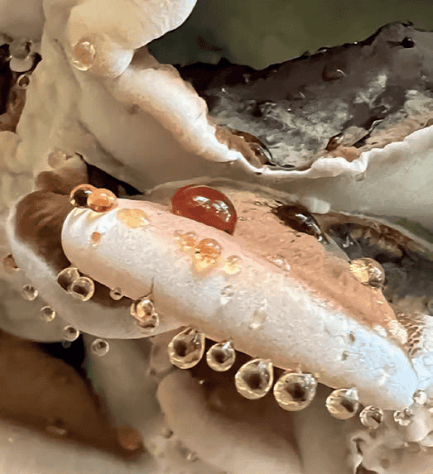
Editor’s Note:
This time, Deanna’s column Global Perspectives is dedicated to the world of mushrooms. Sie talked with industry experts how they use them for sustainable applications in the cosmetics and personal care industry. Alison Cutlan biologist, formulations innovator and mind behind the the brand Biophile Skincare, Kasia Cummings, Founder of Buffalo Gal Skincare, Sejal Topiwala, Marketing Manager in the Americas and APAC region of Active Concepts and Flavia Lagnado commercialization specialist at C-16 Biosciences.
“The world functions because of fungi.” This may sound extraordinary; but as I spoke with Alison Cutlan about the biology, chemistry, and materiality of mushrooms and fungus recently, I was convinced that she’s right, that the power and prevalence of fungi are integral to life on Earth – to our life.
Cutlan is a biologist, with an academic background in medicinal plant research and a well-earned reputation as a skincare formulations innovator. She and I first met in August of 2019 at the New York City edition of Indie Beauty Expo (a trade show once hosted by the Indie Beauty Media Group, where founder-owned brands exhibited to press, buyers, suppliers, and avid consumers).
Building better skincare with biofermentation tech
When we connected at IBE, what we discussed was mushroom biotechnology. Cutlan is the mind behind the formulations and the brand that is – or, rather, was – Biophile Skincare. The brand’s award-winning Bio-shroom Rejuvenating Serum formulation is a triumph of beauty science.
The Shroom Serum, as it’s known to devotees, has as its central active ingredient a ferment (or broth) made using 4 types of bacteria and 3 medicinal mushrooms: Chaga, Tremella, and Reishi. This proprietary broth, the water phase of the serum formulation, is “nutrient-dense”, comprising vitamins, minerals, enzymes, and antioxidants as well as beta-glucans from mushroom cells walls –all of which benefit both the skin and the skin microbiome, says Cutlan. Biophile Skincare products are “biologically supportive,” she explains, because they’re “from a biological source.”
We can see a similar application of fungi biotech at work in the Facial Treatment Essence from P&G’s Japan-based SK-II brand. The brand’s famous PITERA ingredient is the extract of Galactomyces fungi. That extract, INCI name Galactomyces Ferment Filtrate, is A specialized version of the ferment byproduct of Saki production. Indeed, Galactomyces Ferment Filtrate is the hero ingredient in numerous Japanese and Korean serums, essences, and toners, such as Galactomy Niacin Essence from Manyo Factory, Skin Power Original First Essence from MIZON, Galacto Niacin 97 Power Essence from PURITO, and Galactomyces Pure Vitamin C Glow Toner from Some By Mi.

Consumer education and brand innovation
And innovative brands in the US are working with fungi bioferments too. For this installment of the Global Perspectives column, I caught up with Kasia Cummings, Founder of Buffalo Gal Skincare, to learn about her brand’s Magic Mushroom line of products.
Cummings founded Buffalo Gal Skincare in 2010 but only recently began formulating with fungi bioferments, after an interest in beauty-from-within teas and tinctures led her to research herbology, Ayurveda, adaptogens, and probiotics. When she understood how some of these disciplines and technologies could be beneficial for people with cystic acne or skin inflammation, “the next natural step,” she said, “was to move into mushrooms.”
Her boutique brand now includes a Magic Mushroom cleanser, barrier defense serum, eye serum cream, mist, mask, and more. The Magic Mushroom Barrier Defense Mist (formulated with Shiitake and Reishi mushroom ferment) is a good example of how small brands are putting this cutting-edge ingredient tech into the hands of consumers.
Cummings is hopeful that local and regional skincare ingredient suppliers will help fungi bioferments gain traction in the US market as well. She currently sources the bioferments for Buffalo Gal Skincare from the UK and says that most suppliers are in Asia.
Mycelium is starting a fungi revolution within the beauty
In the products and processes that I’ve covered so far, a mushroom (fungi) is the feedstock for a bacteria or other microorganism doing the fermenting. And then the resulting ferment or an extract of it is the cosmetic ingredient.
And that general approach to fungi biotech for personal care applications is what we see happening with Active Concepts’ new Mycofuse Protect hair care ingredient too. According to Sejal Topiwala, the company’s Marketing Manager in the Americas and APAC region, “Mycofuse Protect optimizes sustainable mycelium polysaccharides from Shiitake mushroom, Lentinula edodes, to improve physical and mechanical properties of hair strand strength and elasticity, [provide] a protective shield, forming a barrier against external aggressors such as pollution and thermal damage, and mask visible damage from bleach.” Essentially, she explains, “the adhesive properties of mycelium encourage Mycofuse Protect to attach or fuse to the hair strand, sealing the cuticle.”
Active Concepts, which has ingredient manufacturing facilities in North America, Europe, and Asia, “develops and supplies product locally, fully recognizing the needs of different regional markets,” Topiwala tells me, noting that the supplier’s “core technology platforms include: biofermentation, botanical extracts, complex actives, delivery systems, enzymes, functional actives, and proteins.”
And, to help me understand why Mycofuse Protect is made using Lactobacillus rather than a fungus (or some other micro-organism), she describes how “inoculating a specific biomass with a Lactobacillus culture can ‘digest’ the plant constituents on a chemical level helping to isolate, extract, or chelate specific metabolites of interest. Thus, an innovative approach available associated with probiotics is with bacterial lysates. Bacteriallysates are the product of lysis, a process of inducing stress and rupturing the cell rendering it non-viable. The ruptured cell releases its valuable intracellular components,” explains Topiwala adding that, “bacterial lysates offer a safe alternative to incorporate pro- and prebiotics into cosmetic applications because it is derived from a probiotic organism.”
And Topiwala makes a good argument that by “harnessing the innovative potential of mycelium, Mycofuse Protect is the beginning of a fungi revolution within the beauty industry.”
“Mycelium,” she says, “is forming an influential network in architecture, agriculture, food, fashion, and medical technology. Mycelium-harnessed technology is achieving recognition for skin substitutes and organ replacements, as well as environmental remediation, and alternatives to Styrofoam and plastics. From plant-based meats to reliable building materials, mycelium could curb our reliance on plastics, fuel, and excessive energy use. Fungal fashion is one industry example incorporating the benefits of mycelium and mushrooms to reduce the carbon footprint commonly associated with the textile industry. With minimal waste and energy cost, mycelium offers an answer to sustainability concerns.”
Collaborating with fungus and programming nature
In between and among all the zoom calls and phone calls and email exchanges I had with ingredient makers, beauty product formulators, and brand leaders for this article, I happened upon a particularly mesmerizing moment of fungi in the park near my apartment. And I found myself visiting it nearly every day to see how the fungi was changing, how it was secreting the most orderly droplets of liquid while degrading a fallen tree so swiftly and completely. My curiosity about fungi and mushroom biotech led me write this article, but witnessing this wood-rotting fungi at work in nature only assured me that the brands and suppliers mentioned here have just barely begun to leverage mushrooms and fungi. The opportunity here that metabolic engineering presents for sustainable applications in the cosmetics and personal care industry seems infinite. And I’d like to think that experts like Alison Cutlan, the biologist and formulations innovator, agree. She emphasized during our call that “biodesign, the collaboration with mushrooms to create new materials, that is where the juicy future is!”
Cutlan believes that “fermentation is really a transformative science.” She told me that there are two things you can work with or control in this science: the substrates (the materials that you’re fermenting) and the microbes themselves (the ‘bugs’).
Speaking of microorganisms, yeast is a single-cell fungi that Cutlan describes as, “one of the most useful bio-cells possible.” With basic gene-editing, yeast can be engineered to create any number of valuable molecules. It’s “just like programmable nature,” she says.
Yeast is making palm oil
Enter C-16 Biosciences. If you think you’ve seen C-16 in the news lately, you’re right. The New York City – based biotechnology research company launched GoPalmless.com in November. It’s a platform for partnerships with brands, product manufacturers, R&D leaders, media, investors, and consumers. The company has also just completed a 50,000 liter Torula Oil process.
Torula Oil is C-16’s alternative to palm oil for both food and beauty applications; and it’s made using fungal biotechnology. C-16 is out to “reimage our relationship with nature to leverage the fungal kingdom to develop replacements for palm oil and vegetable oils in general,” says Flavia Lagnado.
Lagnado specializes in commercialization and go-to-market, at C-16 she’s the Product and Strategy Lead. “We chose to use yeastand work with fungi because, as a simple fungi, yeast has a fewadvantages: it grows quickly, is single-celled, and it can be storedin a tank for fermentation as opposed to filamentous fungus.” Plus, she says that C-16 is working with a “robust strain of yeast,” which translates to a “tighter productivity yield and a really efficient process.”
Fungi is an exciting field, says Lagnado, explaining that “in general the fungal kingdom is understudied and undervalued. It was [once] a trash-can classification for not-quite-plants, not-quite-animals.” Now she says, “we’re learning about the value they bring and how to work with them better. Even outside of the lab, there’s a lot of interest from the consumer side in understanding fungi and how they can help us mitigate climate change.”
“Our oil,” says Lagnado, referring to C-16’s Torula Oil, “is a platform replacing derivatives that is deforestation-free.” There are incidental benefits to working with fungi too, according to Lagnado. Carotenoids and sterols found in Torula Oil have tremendous benefits for the skin, she says. She takes care to note that conventional palm oil also contains carotenoids – specifically beta-carotene – but “these are fungal carotenoids; and bring a new active component to brands and consumers looking for effective formulations.”
Fungus is the future of beauty ingredient science
So while Alison Cutlan shuttered Biophile Skincare, moving on to consult on personal care product development and on similar biology and biotech sorts of innovations. She’s not leaving mushrooms and fungus behind. Neither is the beauty industry at large. From the looks of it, there’s a lot more fungal biotech coming our way. “We’re entering a time when so much creativity can happen,” says Cutlan. And, “we are still discovering the intelligence of fungi.”

Deanna Utroske
Deanna Utroske is Editor of the weekly Beauty Insights newsletter and one of the most well-respected critical thinkers in the cosmetics and personal care industry today. She serves our industry as a public speaker, writer, and consultant for supply-side companies.
As a regular contributor to this publication, Deanna writes the Global Perspectives column, covering cosmetic and personal care product formulation trends, emerging ingredient science, and ingredient marketing trends impacting the future of beauty around the world.
As a public speaker, Deanna addresses company teams, higher-education classrooms, and event audiences. She’s spoken at Cosmoprof Worldwide Bologna, in-cosmetics global, MakeUp in Los Angeles, NYSCC Suppliers Day, the Anti-Ageing Skin Care Conference, the International Cosmetics Innovation Conference, Cosmoprof North America, the AIRS International Conference on Genomics & Microbiomics, and many others.
Learn more and find a link to subscribe to the Beauty Insights newsletter at www.DeannaUtroske.com



